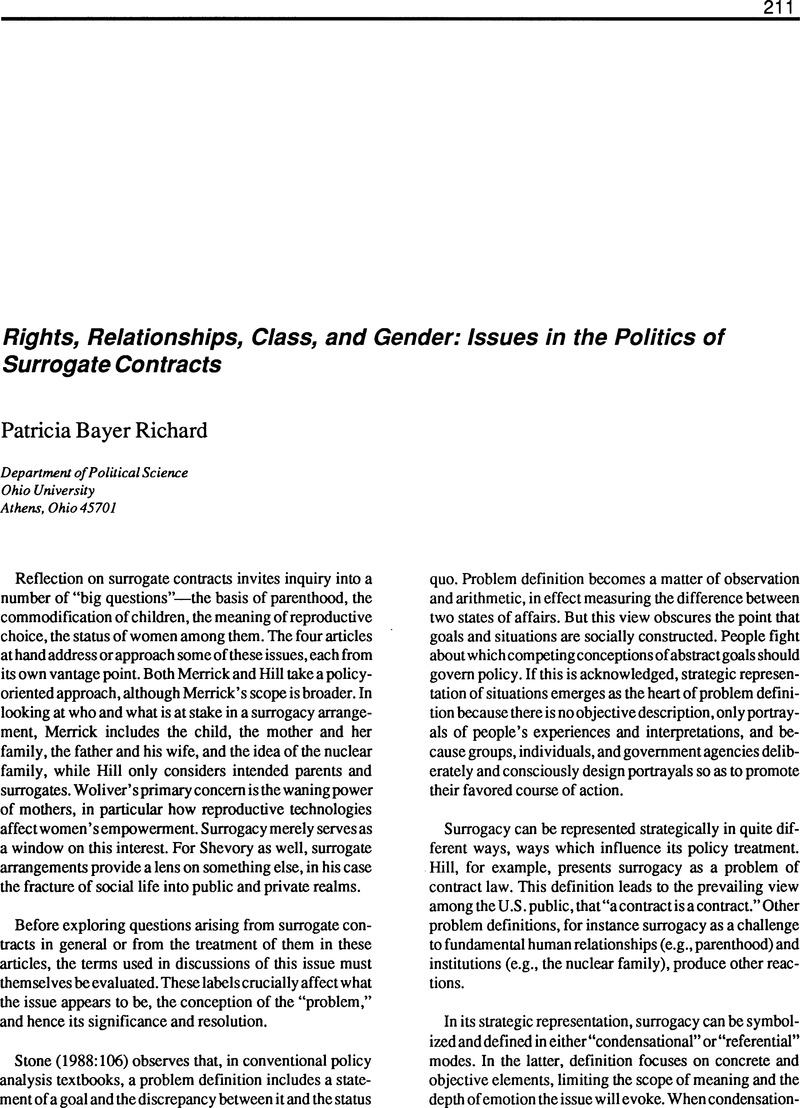No CrossRef data available.
Article contents
Rights, Relationships, Class, and Gender: Issues in the Politics of Surrogate Contracts
Published online by Cambridge University Press: 17 May 2016
Abstract
An abstract is not available for this content so a preview has been provided. Please use the Get access link above for information on how to access this content.

- Type
- Commentaries
- Information
- Politics and the Life Sciences , Volume 8 , Issue 2: Special Issue: The Politics of Surrogacy Contracts , February 1990 , pp. 211 - 215
- Copyright
- Copyright © Association for Politics and the Life Sciences
References
Albury, R. (1984). “Who Owns the Embryo?” In Arditti, R. et al. (eds.), Test-Tube Women: What Future for Motherhood. London: Pandora Press, pp. 54–67.Google Scholar
Andrews, L. (1989). Between Strangers: Surrogate Mothers, Expectant Fathers, and Brave New Babies. New York: Harper and Row.Google Scholar
Andrews, L.(1988). “Surrogate Motherhood: The Challenge for Feminists,” Law, Medicine & Health Care 16(1-2):72–80.Google Scholar
Blank, R. H. (1984). Redefining Human Life: Reproductive Technologies and Social Policy. Boulder, Colo.:Westview.Google Scholar
Carson, S. A. (1989). “Sex Selection: The Ultimate Family Planning.” Endocrine and Fertility Forum 12 (2):1–3.Google Scholar
Committee of Inquiry into Human Fertilization and Embryology. (1985). A Question of Life: The Warnock Report on Human Fertilization and Embryology. Oxford: Basil Blackwell.Google Scholar
Edelman, M. (1964). The Symbolic Uses of Politics. Urbana, Ill.: University of Illinois Press.Google Scholar
Field, M. A. (1988). Surrogate Motherhood. Cambridge, Mass.: Harvard University Press.Google Scholar
Gilligan, C. (1982). In a Different Voice. Cambridge, Mass.: Harvard University Press.Google Scholar
Hanmer, J. (1987). “Transforming Consciousness: Women and the New Reproductive Technologies.” In Corea, Gina et al. (eds.), Man-Made Women: How New Reproductive Technologies Affect Women. Bloomington, Ind.: Indiana University Press, pp. 88–109.Google Scholar
Hershey, M. R., and West, D. M. (1983). “Single-Issue Politics: Pro-life Groups and the 1980 Senate Campaign.” In Cigler, A. J. and Loomis, B. A. (eds.),Interest Group Politics. Washington, D.C.: CQ Press, pp. 31–59.Google Scholar
Overall, C. (1987). Ethics and Human Reproduction: A Feminist Analysis. Boston: Allyn and Unwin.Google Scholar
President's Commission for the Study of Ethical Problems in Medicine and Biomedical and Behavioral Research. (1983). Screening and Counseling for Genetic Conditions: The Ethical and Legal Implications of Genetic Screening, Counseling, and Education Programs. Washington, D.C.: U.S. GPO.Google Scholar
Rothman, B. K. (1984). “The Meanings of Choice in Reproductive Technology.” In Arditti, R. et al., (eds.),Test-Tube Women: What Future for Motherhood? London: Pandora Press, pp. 23–33.Google Scholar
Stone, D. (1988). Policy Paradox and Political Reason. Glenview, Ill.: Scott, Foresman.Google Scholar




